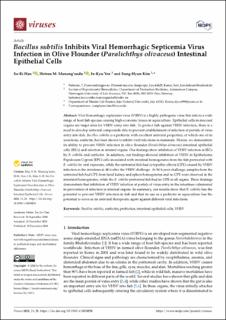| dc.contributor.author | Han, So-Ri | |
| dc.contributor.author | Munang´andu, Hetron Mweemba | |
| dc.contributor.author | Yeo, In-Kyu | |
| dc.contributor.author | Kim, Sung-Hyun | |
| dc.date.accessioned | 2021-03-29T08:35:55Z | |
| dc.date.available | 2021-03-29T08:35:55Z | |
| dc.date.created | 2021-03-24T16:53:33Z | |
| dc.date.issued | 2020 | |
| dc.identifier.citation | Viruses. 2020, 13 (1), 1-10. | en_US |
| dc.identifier.issn | 1999-4915 | |
| dc.identifier.uri | https://hdl.handle.net/11250/2735864 | |
| dc.description.abstract | Viral hemorrhagic septicemia virus (VHSV) is a highly pathogenic virus that infects a wide range of host fish species causing high economic losses in aquaculture. Epithelial cells in mucosal organs are target sites for VHSV entry into fish. To protect fish against VHSV infection, there is a need to develop antiviral compounds able to prevent establishment of infection at portals of virus entry into fish. Bacillus subtilis is a probiotic with excellent antiviral properties, of which one of its secretions, surfactin, has been shown to inhibit viral infections in mammals. Herein, we demonstrate its ability to prevent VHSV infection in olive flounder (Paralichthys olivaceus) intestinal epithelial cells (IECs) and infection in internal organs. Our findings show inhibition of VHSV infection in IECs by B. subtilis and surfactin. In addition, our findings showed inhibition of VHSV in Epithelioma Papulosum Cyprini (EPC) cells inoculated with intestinal homogenates from the fish pretreated with B. subtilis by oral exposure, while the untreated fish had cytopathic effects (CPE) caused by VHSV infection in the intestines at 48 h after the VHSV challenge. At 96 h post-challenge, samples from the untreated fish had CPE from head kidney and spleen homogenates and no CPE were observed in the intestinal homogenates, while the B. subtilis-pretreated fish had no CPE in all organs. These findings demonstrate that inhibition of VHSV infection at portals of virus entry in the intestines culminated in prevention of infection in internal organs. In summary, our results show that B. subtilis has the potential to prevent VHSV infection in fish and that its use as a probiotic in aquaculture has the potential to serve as an antiviral therapeutic agent against different viral infections. | en_US |
| dc.language.iso | eng | en_US |
| dc.rights | Attribution-NonCommercial-NoDerivatives 4.0 Internasjonal | * |
| dc.rights.uri | http://creativecommons.org/licenses/by-nc-nd/4.0/deed.no | * |
| dc.title | Bacillus subtilis Inhibits Viral Hemorrhagic Septicemia Virus Infection in Olive Flounder (Paralichthys olivaceus) Intestinal Epithelial Cells | en_US |
| dc.type | Peer reviewed | en_US |
| dc.type | Journal article | en_US |
| dc.description.version | publishedVersion | en_US |
| dc.source.pagenumber | 1-10 | en_US |
| dc.source.volume | 13 | en_US |
| dc.source.journal | Viruses | en_US |
| dc.source.issue | 1 | en_US |
| dc.identifier.doi | 10.3390/v13010028 | |
| dc.identifier.cristin | 1900804 | |
| cristin.ispublished | true | |
| cristin.fulltext | original | |
| cristin.qualitycode | 1 | |

